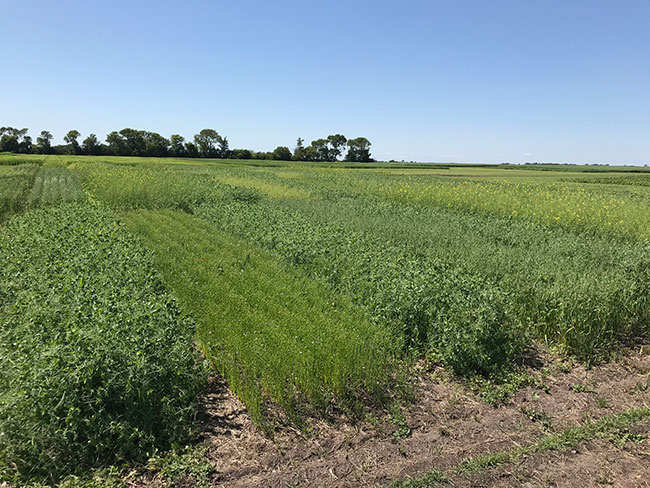
Features
Research
Intercropping yellow pea can produce higher returns
Pea-canola, pea-mustard and pea-oat intercrops improved pea production.
January 24, 2024 By Bruce Barker
 Pea intercrop trials identified the most profitable cropping system.
Photo courtesy of Scott Chalmers.
Pea intercrop trials identified the most profitable cropping system.
Photo courtesy of Scott Chalmers. Intercropping has the potential to help reduce weed, disease and insect pressure while maintaining or improving yields at the same time. The drawbacks, though, such as seed separation at harvest, can be labour-intensive and time-consuming. Several research projects have been conducted at the Westman Agricultural Diversification Organization (WADO) in Melita, Man., that examine this practice.
“My take on intercropping as a general feeling is that it has a good fit where peas might struggle when grown on their own,” says Scott Chalmers, an applied research specialist with WADO. “In any given year in Manitoba, I would estimate that there are at least 10 fields with pea-canola intercrops.”
Chalmers says a pea intercrop can bring benefits beyond higher overall productivity. These include fewer aphids that may not require insecticidal application, lower disease pressure from Ascochyta seed-borne diseases, the ability to use excess moisture with the addition of canola in the stand, and better pea lodging resistance.
In a study led by Chalmers at Melita, Reston, and Roblin, Man., from 2019 to 2021, yellow peas were intercropped with flax, oats, wheat, canola, or mustard, and were compared to monocrops of each crop. In the intercrops, peas were seeded at the recommended rate for monocropping, and the intercrops were seeded at 50 per cent of their recommended rate. Apart from some nitrogen (N) in the starter phosphorus/potassium/sulfur blend, no additional N was applied.
At Melita, the highest average pea yield was in the pea-mustard intercrop at 32.9 bu/ac (2208 kg/ha), although it was statistically similar to pea-flax, pea-wheat and pea-canola. The pea-canola intercrop at Roblin had the highest pea yield at 23.3 bu/ac (1567 kg/ha), while the pea-canola intercrop at Reston produced the highest pea yield at 5.9 bu/ac (398 kg/ha).
Pea yields were impacted by low precipitation in 2020 and 2021 at Melita and Reston, while Roblin had near-normal precipitation. Yields at Reston were very low due to Aphanomyces and Fusarium root rots.
The total land equivalent ratio (TLER) was calculated for each site and intercrop. This ratio represents the relative land area under monocrops needed to produce yields equivalent to intercrops. A value greater than one means that the intercrop outperforms the monocrop.
Pea-canola provided the highest TLER at Roblin with a value of 2.03 and at Reston at 1.84. There was no significant difference in TLER among intercrops and monocrops at Melita.
Net revenues were also calculated by subtracting operating costs from gross revenues based on 2019 prices. The commodity prices at that time were $7 per bushel for peas, $12.75 for flax, $3.75 for oats, $6.75 for wheat, $11 for canola and $19 for mustard. Net revenues of pea-mustard, pea-canola, and pea-oat intercrops were significantly greater than the pea monocrop at Roblin and Reston. Net revenues did not differ between intercrops and pea monocrop at Melita.
“There are multiple external benefits that add up in the system, but I estimate that you need a 20 per cent yield benefit to make the economics work to pay for the extra separation cost,” says Chalmers.

Lower weed and disease pressure
A second study was conducted at Reston with pea intercropped with canola, camelina, or yellow mustard. Pea-canola and pea-mustard were planted in 2019 and 2020, and pea-camelina replaced pea-canola in 2021. The crops were planted on land with Aphanomyces and Fusarium root rot disease pressure.
Three pea-intercrop seeding ratios of 70:30, 50:50, and 30:70 were planted. The objective was to observe how seeding rates impacted intercropped peas and if there were any effects on Aphanomyces and Fusarium root rot incidence, weed pressure, grain yield and grain quality over three consecutive years. In all three years, pea-mustard consistently out-yielded monocropped peas, with TLER consistently over one, ranging from 1.6 to 1.8. Pea-mustard intercrop also reduced weed biomass. Over the two years, pea-canola had TLERS of 2.0 to 2.4, out-yielding mono-crop peas. For example, pea-canola seeded at a ratio of 70:30 pea to canola yielded 11.2 bu/ac (749 kg/ha) of peas plus 31.7 bu/ac (1781 kg/ha) of canola, compared to pea monocrop at 10.8 bu/ac (727 kg/ha). The pea-canola intercrop seeded at 70:30 ratio also had lower Aphanomyces DNA detected in the pea roots. This suggests that intercropping may help suppress root rot disease. However, the heavy root rot pressure at Reston heavily influenced the TLER – pea yields were low, and the companion crop provided high yields to maintain reasonable net revenues.
The pea-camelina intercrop also out-yielded monocrop peas, with the highest TLER at a 50:50 seeding ratio (1.48) and a TLER of 1.39 at the 30:70 seeding ratio. Similar to the mustard and canola intercrops, camelina contributed significantly to the yield and TLER.
“The success of the system depends on a few factors. In a year with excess moisture, intercropping peas is a great match with other crops,” says Chalmers. “Field topography is also a factor. Canola will take over in the low spots, and peas like the higher land.”